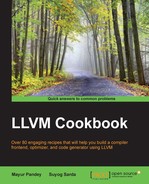All LLVM passes are subclasses of the pass class, and they implement functionality by overriding the virtual methods inherited from pass. LLVM applies a chain of analyses and transformations on the target program. A pass is an instance of the Pass LLVM class.
Let's see how to write a pass. Let's name the pass function block counter; once done, it will simply display the name of the function and count the basic blocks in that function when run. First, a Makefile needs to be written for the pass. Follow the given steps to write a Makefile:
- Open a
Makefilein thellvm lib/Transformfolder:$ vi Makefile - Specify the path to the LLVM root folder and the library name, and make this pass a loadable module by specifying it in
Makefile, as follows:LEVEL = ../../.. LIBRARYNAME = FuncBlockCount LOADABLE_MODULE = 1 include $(LEVEL)/Makefile.common
This Makefile specifies that all the .cpp files in the current directory are to be compiled and linked together in a shared object.
Do the following steps:
- Create a new
.cppfile calledFuncBlockCount.cpp:$ vi FuncBlockCount.cpp - In this file, include some header files from LLVM:
#include "llvm/Pass.h" #include "llvm/IR/Function.h" #include "llvm/Support/raw_ostream.h"
- Include the
llvmnamespace to enable access to LLVM functions:using namespace llvm;
- Then start with an anonymous namespace:
namespace { - Next declare the pass:
struct FuncBlockCount : public FunctionPass { - Then declare the pass identifier, which will be used by LLVM to identify the pass:
static char ID; FuncBlockCount() : FunctionPass(ID) {} - This step is one of the most important steps in writing a pass—writing a
runfunction. Since this pass inheritsFunctionPassand runs on a function, arunOnFunctionis defined to be run on a function:bool runOnFunction(Function &F) override { errs() << "Function " << F.getName() << ' '; return false; } }; }This function prints the name of the function that is being processed.
- The next step is to initialize the pass ID:
char FuncBlockCount::ID = 0;
- Finally, the pass needs to be registered, with a command-line argument and a name:
static RegisterPass<FuncBlockCount> X("funcblockcount", "Function Block Count", false, false);Putting everything together, the entire code looks like this:
#include "llvm/Pass.h" #include "llvm/IR/Function.h" #include "llvm/Support/raw_ostream.h" using namespace llvm; namespace { struct FuncBlockCount : public FunctionPass { static char ID; FuncBlockCount() : FunctionPass(ID) {} bool runOnFunction(Function &F) override { errs() << "Function " << F.getName() << ' '; return false; } }; } char FuncBlockCount::ID = 0; static RegisterPass<FuncBlockCount> X("funcblockcount", "Function Block Count", false, false);
A simple gmake command compiles the file, so a new file FuncBlockCount.so is generated at the LLVM root directory. This shared object file can be dynamically loaded to the opt tool to run it on a piece of LLVM IR code. How to load and run it will be demonstrated in the next section.
- To know more on how a pass can be built from scratch, visit http://llvm.org/docs/WritingAnLLVMPass.html
